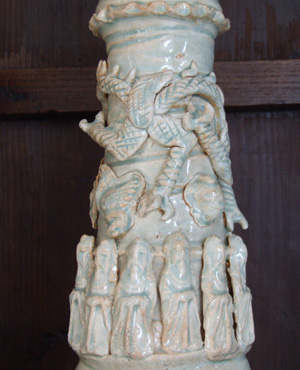
SONG or YUAN DYNASTY 12th to EARLY 14th CENTURY Qingbai Ware
A Pair of Large Song Dynasty or Yuan Qingbai Jars and Covers Made for Offerings in a Tomb, 12th to Early 14th Century. Probably Produced at a Kiln in Fujian, the Sugary Texture of the Body Helps Confirm the Jars Were Produced in Fujian. The Tall Jars with Short Bodies and Long Necks Decorated with Appliqués Over Grooves Cut into the Wet Clay. The Sugary Texture of the Body Helps Confirm that the Jars Were Produced in Fujian.
SOLD
- Condition
- The vases are very similar in colour. They look different in the first photograph because of the lighting. The vases are in excellent condition, they have some crazing which is slightly discoloured. The only damage is to the end of one of the tails of the bird finials, the end of the other birds tail has been restuck, there is a small loss to the crest of this bird.
- Size
- The vases are of different height, however the shorter vase becomes the tallest when measured to the top of the birds beak. 59.6 cm (22inches)
- Provenance
- N/A
- Stock number
- 21780
- References
- For a Qingbai jar of this type at the Victoria and Albert Museum see : Qingbai Ware, Chinese Porcelain of the Song and Yuan Dynasties (Edited by Stacey Pierson, Percival David Foundation. 2002. ISBN 0-7286-0339-X) page 180 item 97. For a pair of Qingbai jars of this type from a tomb dated to 1227 and another from a tomb dated 1315 see : Chinese Ceramics from Datable Tombs and Some Other Dated Material, A Handbook (J.M. Addis, Sotheby Parke Bernet,1978.ISBN 0-85667-039-1) pages 34 and 36. For other pairs from datable tombs see : Dated Qingbai Wares of the Song and Yuan Dynasties (Ching Leng Foundation,1998) page 71, item 70. The Song Dynasty pair illustrated can be dated to 1209 and come from Nanchang County, and for other pair dated to 1211 see page 74, Item 76. An example of a later type, from the Yuan Dynasty (Dated to 1293) is illustrated on page 81, item 94. For further Song vases of this type see our `Sold` items stock number 17588, 20832, 20833.
Information
These Mingqi jars were made as pairs, numerous comparable examples are known in the literature, however they vary enormously in their decoration. The hand-thrown jars were applied with mould-made appliqués, these, like the later Fujian appliqués found on Blanc de Chine vary incredibly from object to object as does their layout of the design. Most have a collar of figures standing next to one another, sometimes with a kowtowing prostrate figure among them.
The bird finials represents the Vermilion Bird of the South, the coiled Dragon is the Green Dragon of the East. The collar of figures represent gods, above them are animals including a domesticated dog with a bell around it`s neck.







